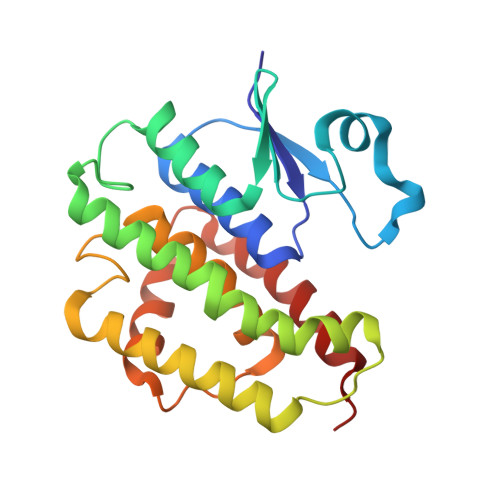Crystallographic survey of active sites of an unclassified glutathione transferase from Bombyx mori
Kakuta, Y., Usuda, K., Nakashima, T., Kimura, M., Aso, Y., Yamamoto, K.(2011) Biochim Biophys Acta 1810: 1355-1360
- PubMed: 21756974
- DOI: https://doi.org/10.1016/j.bbagen.2011.06.022
- Primary Citation of Related Structures:
3AY8 - PubMed Abstract:
Glutathione transferase (GST) catalyzes a major step in the xenobiotic detoxification pathway. We previously identified a novel, unclassified GST that is upregulated in an insecticide-resistant silkworm (Bombyx mori) upon insecticide exposure. Here, we sought to further characterize this GST, bmGSTu, by solving and refining its crystal structure and identifying its catalytic residues. The structure of wild-type bmGSTu was determined with a resolution of 2.1Å by synchrotron radiation and molecular modeling. Potential catalytic residues were mutated to alanine by means of site-directed mutagenesis, and kinetic data determined for wild-type and mutated bmGSTu. We found that bmGSTu occurred as a dimer, and that, like other GSTs, each subunit displayed a G-site and an H-site in the active center. Bound glutathione could be localized at the G-site. Kinetic data of the mutated forms of bmGSTu show that Val55, Glu67, and Ser68 in the G-site are important for catalysis. Furthermore, the H-site showed some unique features. This is the first study to our knowledge to elucidate the molecular conformation of this B. mori GST. Our results indicate that residues Val55, Glu67, and Ser68, as well as Tyr7 and Ser12, in the glutathione-binding region of bmGSTu are critical for catalytic function. Our results, together with our previous finding that bmGSTu was preferentially induced in an insecticide-resistant strain, support the idea that bmGSTu functions in the transformation of exogenous chemical agents. Furthermore, the unique features observed in bmGSTu may shed light on mechanisms of insecticide resistance.
- Faculty of Agriculture, Kyushu University Graduate School, 6-10-1 Hakozaki, Higashi-ku, Fukuoka 812-8581, Japan.
Organizational Affiliation:

















